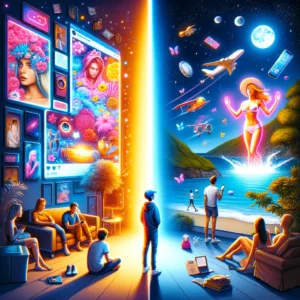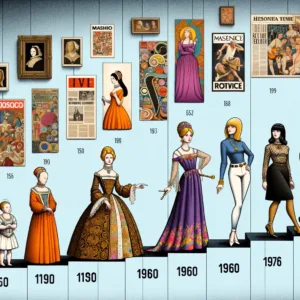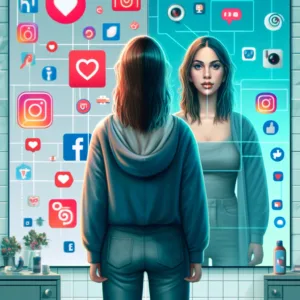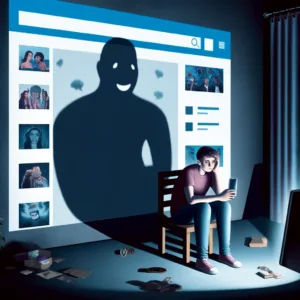In our previous discussions on media literacy and combating online disinformation, one crucial aspect deserves deeper attention: the perception of reality through Social Networks. Although briefly mentioned before, this facet of our digital interaction plays a decisive role in shaping our understanding of the world and thus merits a more detailed exploration. This new article will specifically focus on the impacts of the often idealized representations conveyed by social Networks, and how these influence the reality perception of young users. We also invite you to review our previous article on balanced social media use.

Introduction
In our modern society, the integration of digital technologies into daily life has increased exponentially, especially among younger generations. The omnipresence of screens has raised a multitude of concerns, particularly regarding their impact on the cognitive, social, and emotional development of children and adolescents. Today’s youth navigate a world where the boundaries between digital content and reality are often blurred, making it difficult to distinguish between the two. This confusion can affect their perception of the world and themselves, and raises important questions about how to manage this new reality.
A Real Challenge
Faced with these challenges, it is essential to examine the roles that parents and educators can play in helping young people better understand and differentiate digital interactions from their experiences in real life. This article aims to explore various strategies and approaches that can support youth in establishing a healthy balance between screen time and engagement in the real world. By providing tailored tools and knowledge, we can equip children and adolescents to navigate discerningly in this omnipresent digital environment, while promoting their well-being and overall development.
A Hot Topic
A burning issue in the media and political arena is the proposal to ban the TikTok application in several countries. This proposal has sparked lively discussions about the potential risks associated with data security and foreign influence, as well as implications for freedom of expression and digital innovation.
These debates are fueled by growing concerns about how platforms can be used to spread manipulated content and unduly influence audiences, particularly young people. While some see this ban as a necessary measure to protect user privacy and security, others perceive it as a hindrance to personal freedom and a potentially excessive response to the challenges posed by content management and social media regulation.
These discussions highlight the ongoing challenge of striking a balance between security, freedom of expression, and platform responsibility in regulating their content.
Understanding the Debate Through a Washington Post Article.
New York Times Article about the debat.
 Evolution of Beauty Standards
Evolution of Beauty Standards
Throughout history, beauty standards have constantly evolved, shaped by cultural, economic, and social influences. From the appreciation of voluptuous forms in the Renaissance era to the idealization of thinness in the 1960s, these dictates have always had a profound impact on individuals’ self-perception. Each era has upheld its own ideals, often inaccessible to the majority, thus creating unrealistic expectations that have led to body dissatisfaction and eating disorders. These standards have been perpetuated by traditional media such as television and magazines, which have long held the monopoly on the image of the ideal beauty.
The evolution of beauty standards over time.
Impact and Heightened Unrealistic Perception by Social Media
With the advent of social media, these perceptions have undergone a significant transformation. Platforms like Instagram, Snapchat, and TikTok have revolutionized how beauty is represented and perceived. On one hand, they have democratized who can be seen and have given everyone the opportunity to share their own image. However, this apparent openness has also led to a new form of aesthetic pressure. Filters and photo editing tools, accessible to all, have created an unreal and omnipresent standard of perfection. Additionally, constant interaction and comparison with other users can exacerbate personal insecurities and promote a relentless quest for approval through likes and comments.
Social media has thus contributed to intensifying pressures around beauty standards, making them more visible and constantly evolving. They have also facilitated the emergence of counter-cultural movements that defy these traditional ideals and encourage broader acceptance of body and aesthetic diversity. Despite these positive aspects, the challenge remains to navigate an environment where idealized images continue to deeply influence perceptions of beauty and personal worth.
Impact of filter overuse on self-perception : The scientific view
Understanding the Altered Perception Social Media Can Induce
Perception versus Reality
In the digital age, the constant exposure of young people to various types of content through their screens — whether it’s social media, video games, or online advertisements — plays a predominant role in how they perceive the world. This exposure is not neutral: it shapes their reality, influences their aspirations, and alters their self-perception.
The images and narratives conveyed by these platforms often fall far short of reflecting a faithful reality; instead, they tend to present an idealized version of life, people, and success. For example, representations of beauty in advertisements and social media are frequently retouched, offering perfect and often unattainable visions that can greatly diverge from everyday reality. These perfected images create unrealistic standards of beauty, which may seem normative but are actually extremely rare or unattainable in real life.
A Potentially Dangerous Impact
The impact of these idealized representations is profound, particularly among adolescents, for whom identity and self-esteem are still developing. When young people compare their appearance or their lives to these highly filtered and edited images, they may feel a sense of inadequacy or lack. This constant comparison can lead to a skewed perception of their own worth, negatively influencing their self-esteem and mental well-being.
Moreover, these contents also shape their expectations regarding success and social norms. Young people may believe that certain achievements are easily attainable, as struggles and failures are rarely shown on these platforms. This can lead to frustration when their own experiences do not match up to these unrealistic expectations.
 Amplification of Inescapable Myths
Amplification of Inescapable Myths
Social media amplifies these distortions by presenting filtered and embellished versions of everyday life. Retouched images and videos are commonplace, and their omnipresence can lead children and adolescents to evaluate their own lives less favorably, exacerbating feelings of inadequacy and social anxiety. This disconnect between real life and carefully selected and edited images online can disrupt their understanding of normalcy and influence their social behavior and emotional development.
Glorification of Material Wealth
Furthermore, these platforms tend to glorify an image of “success” closely associated with material wealth and an apparently perfect “social life.” This representation can be particularly toxic for young people who are isolated or those who experience very different realities, often making them feel marginalized or unsuccessful compared to their peers. This disconnect between real life and carefully selected and edited images online can disrupt their understanding of normalcy and influence their social behavior and emotional development. Consequently, it is crucial to support young people in building a resilient and realistic self-image by teaching them to discern the staging often hidden behind idealized posts.
Role of Algorithms
The role of algorithms in shaping young people’s perceptions is fundamental and often underestimated. Social media platforms, in their quest to maximize user engagement, deploy increasingly sophisticated algorithms. These systems are designed to learn from users’ online behaviors and then present them with content that, according to data, is most likely to maintain their attention. While this personalization may make the user experience more engaging, it also promotes the most sensational or polarizing content, often at the expense of truthfulness or educational value.
This dynamic can have significant consequences for young users. By highlighting content that confirms pre-existing beliefs, algorithms can reinforce misconceptions and encourage problematic behaviors. For example, a teenager inclined towards unrealistic beauty ideals may find themselves bombarded with advertisements and posts that glorify these standards, exacerbating their insecurities and potentially deteriorating their self-esteem.
Algorithms that Reinforce Our Ideas
Furthermore, extreme personalization can lead to the creation of “filter bubbles,” where users only see information that reinforces their perspectives, thus isolating young people in homogeneous information environments. These bubbles can seriously distort their perception of social and cultural reality, exposing them only to viewpoints and ideals that reflect their own interests and beliefs. This isolation can make it difficult for young people to develop a comprehensive and nuanced understanding of global issues and human diversities.
It is therefore crucial to educate children and adolescents about how algorithms work and the influence they can have on their content consumption. By teaching young people to question the mechanisms behind the content they consume, we can help them develop digital resilience, enabling them to navigate the digital environment with a more critical and diversified perspective.
Impact of Social Media/Reality Confusion on Well-being
Psychological Consequences
The difficulty in distinguishing between digital content and reality can have profound and lasting effects on the psychological well-being of young people. When children and adolescents daily absorb idealized images and narratives that do not match their reality, it can lead to a distortion of self-perception and the world around them. This confusion can diminish self-esteem, especially when young people compare their physical appearance or level of success to unrealistic standards constantly displayed online. Moreover, this constant pressure to measure up to unattainable ideals can lead to anxiety and depression disorders, as young people may feel perpetually inadequate or unsuccessful.
The impacts are not limited solely to self-esteem; they also extend to overall mental health. Young people exposed to content that glorifies certain behaviors or appearances may develop eating disorders, symptoms of social anxiety, and a general sense of unease. These disorders can manifest as social isolation, reluctance to engage in real-world activities, or increased dependence on digital interactions as the sole form of social validation.
Importance of Digital Resilience
In the face of these challenges, the importance of cultivating digital resilience in young people becomes crucial. Digital resilience is not just about the ability to use technology safely, but also the ability to recover from the negative impacts of online exposure. This involves teaching young people to recognize and critique digital content, to understand their own intrinsic value beyond screens, and to cultivate relationships and experiences in the real world that strengthen their mental health and well-being.
The Positive Impacts of Social Media: Finding Balance
While social media is often criticized for its negative effects on mental health and well-being, it is also important to recognize the benefits it can offer, especially in terms of social connection and community support. For many people, especially those who may feel isolated or marginalized in their immediate environment, social media provides a vital space to find peers and feel understood.
Finding Community
Online platforms allow individuals to connect with groups that share similar interests, challenges, or identities. For young people in particular, who are often searching for their identity and place in the world, social media can play a crucial role by offering spaces where they feel accepted and valued. These virtual communities can provide important emotional support, guidance, and a sense of belonging, which are essential for personal and social development.
Support and Expression Network
Furthermore, social media can serve as powerful platforms for personal expression and awareness on various topics, including those that are often less discussed in traditional media. Young people can use these platforms to express themselves, share their creations, thoughts, and even mobilize around causes they care about. This capacity for expression can strengthen self-confidence and encourage young people to become active and engaged citizens.
Need for Balance
However, it is crucial to maintain a healthy balance in the use of social media to avoid potential pitfalls such as overuse or exposure to negative content. Parents and educators have an important role to play here, helping young people understand how to navigate these platforms responsibly and recognize when their usage begins to have a negative impact on their well-being.
- Tip 1: Encourage young people to be selective in their online interactions, choosing communities that support their well-being and avoiding those that foster negativity or toxic comparison.
- Tip 2: Educate young people on the importance of taking regular breaks from social media to reconnect with the real world and engage in face-to-face interactions.
- Tip 3: Initiate offline experiences that are meaningful and impactful (such as walks, discovering new landscapes, attending concerts, etc.).
- Tip 4: Lead by example as an adult by also adopting a balanced use of technology, to reinforce these behaviors in young people.
By highlighting the positive aspects of social media while promoting conscious and balanced usage, we can help young people make the most of these digital tools while protecting their mental health and well-being.
For more information, check out our article on balanced use of social media.

Conclusion
In our approach to digital media and social networks, it is imperative to strike a balance between constructive criticism and recognition of the positive aspects. Constantly demonizing the use of screens and online platforms can overshadow the substantial benefits they offer, including connection, community building, and personal expression. However, it is equally crucial to remain vigilant in the face of the challenges they present, such as impacts on mental health, self-esteem, and perception of reality.
Awareness of the negatives is essential for self-protection and developing strategies for digital resilience, but it is also important to value and leverage the positive opportunities that digital technologies provide. This includes using these tools to strengthen social ties, explore personal interests, and participate in relevant social movements.
An Aid for Navigation
In this light, Mr. Arthur’s system emerges as a valuable ally. Mr. Arthur helps young users make the most of their online time while limiting the risks of overconsumption or exposure to harmful content. With features such as encouraging disconnect periods and setting screen time limits, but above all by promoting an educational use of screens.
Rather than outright rejecting digital advancements, let’s adopt a more nuanced and proactive perspective. By educating and equipping our youth with the necessary tools to navigate the digital landscape safely and responsibly, we can prepare them to use these technologies in ways that enrich their lives without compromising quality. Mr. Arthur represents a step in this direction, offering a solution that integrates both the benefits of digital technologies and the necessary precautions for healthy use.
 Evolution of Beauty Standards
Evolution of Beauty Standards
 Amplification of Inescapable Myths
Amplification of Inescapable Myths